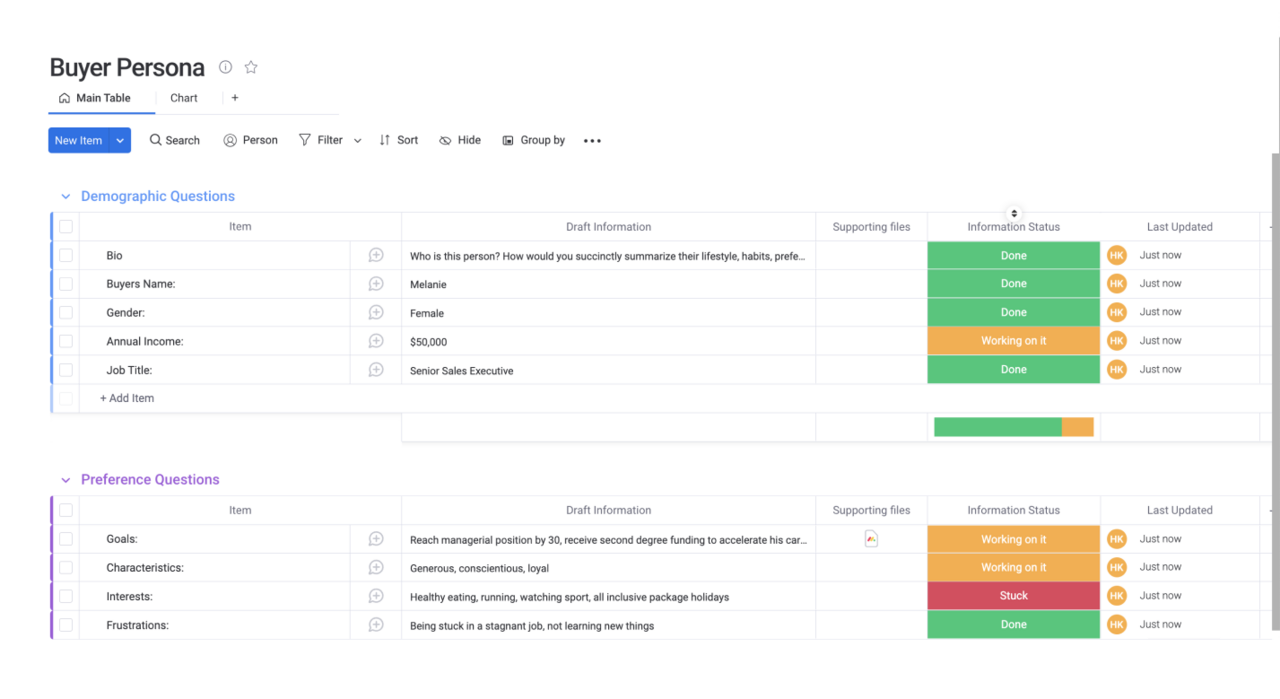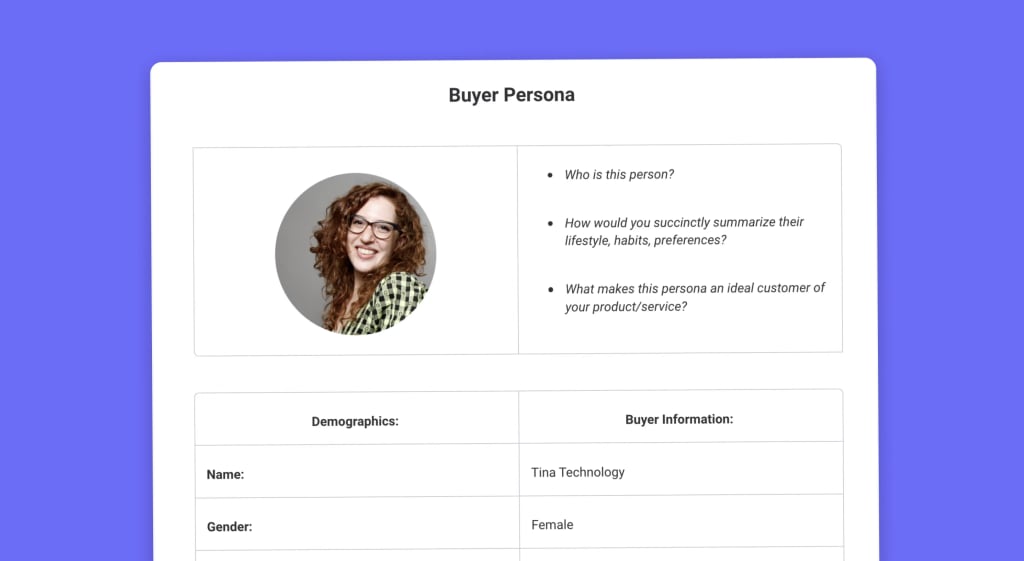Effective marketing connects with your customer base by building a real relationship between the client and your brand. As with any relationship, however, you’ll need to get to know your target customers before they begin to see you as a reliable, trustworthy resource. With a customer segment template, you can reveal and document personality traits, behaviors, and interests. These characteristics help you create buyer personas for your business, which serve as a model for marketing strategies that appeal to different groups of customers.
Before we begin to delve into the customer segment template, let’s define this meaningful marketing tool. We’ll also discuss the features you’ll find when you try the template on monday.com.
What is a customer segment template?
Customer segmentation strategy helps you understand the right approach to use for each group of individuals you envision using your products and services.A customer segment template helps you organize your customer segmentation strategy, which helps you understand the right approach for targeting each group of individuals who may use your products or services.
These people share similar characteristics that influence their potential need for your business offerings. Most basic customer segment templates describe each of your target markets in four key areas:
- Demographics: Gender, age, career, and stage of life (single or married with kids, for example)
- Geography: Region and population density (rural, urban, or suburban areas)
- Behavioral: Includes data about how your customers interact with your business to help you understand how your product or service could fit their needs
- Psychographic: Lifestyle, hobbies and interests, and socioeconomic status
These aren’t the only ways to break down your customer segments, however. Other segmentation types may include:
- Needs: The “must” features your clients require from your solutions
- Technographic: Whether customers access content through their mobile device or a desktop computer and what software they frequently use
- Values: May include social justice concerns or economic considerations of particular populations
With this description in mind, let’s look at some of the benefits of using a customer segment template for more effective marketing.
Why use a customer segment template?
Each distinct audience of your marketing campaign has different needs and expectations when it comes to your brand. Using a customer segment template speeds up the process of building out each unique buyer persona.
In addition to building a strong connection with your clients, this tool can help your business:
- Determine which customers generate the most value
- Create content and plan interactions that facilitate customer loyalty
- Develop solutions for challenges faced by your customer segments
- Build an effective customer support and service program
- Tailor marketing campaigns to audience preferences to improve conversion rates
- Find new ways to expand your market share by catering to the needs of your clients
The examples below can provide even more inspiration about ways to use this tool.
What are some examples of a customer segment template?
The matrix template is the most common visual market segmentation template. To create a market segmentation matrix, simply draw a matrix with four boxes, labeling each as a demographic, geographic, behavioral, or psychographic segmentation. Then, fill in the characteristics that fit your ideal client in the corresponding box of the matrix. You can also incorporate specialized segmentation types, such as:
- RFV: This acronym stands for recency, frequency, and value. By looking at buying behavior such as how often the individual purchases from your brand and how much they typically spend, you can drive revenue by recommending add-on purchases, offering purchase incentives for brand-new or former clients, and creating effective loyalty programs.
- Seasonality: If you’re targeting customers in different regions, you may need to consider factors such as weather and cultural celebrations. For example, Australian customers probably won’t be bathing suit shopping in July because it’s winter in Australia at that time of year.
- Customer status: This factor reflects whether someone actively buys from your brand or purchased from you previously but not in the past few months. Knowing someone’s status lets you learn how to attract them back to your business.
- Customer value: Closely related to RFV, this metric looks solely at someone’s lifetime spending with your brand. You can use this information to fine-tune your marketing for various value segments.
Companies with big data capabilities can harness the power of artificial intelligence and machine learning to automatically create smart segmentation strategies, but you don’t need to be a tech guru to take advantage of customer segmentation. If you’re ready to get started, read on for more about monday.com’s Buyer Persona Template for customer segmentation.
Customer segment template on monday.com

monday.com’s Buyer Persona Template optimizes the customer segmentation process whether you have one or dozens of target audiences. It’s designed to document the key characteristics of your customers with customizable segment categories like demographics, behavior, and psychometrics. You can draft your content on the template board and then switch to the presentation view to see everything in one place. Like all our resources, this template works on monday.com’s core Work OS platform. Our system effortlessly integrates with hundreds of software programs and apps, so you’re sure to find your favorite tools on the list. You can also expand your capabilities by accessing related resources that work well with the Buyer Persona Template.
Related templates on monday.com
We recommend these complementary tools to make the most of your Buyer Persona Template.
Positioning statement template
The Positioning Statement Template is designed to enhance customer engagement and improve your audience’s identification with your brand. This internal resource describes and documents your company’s desired perception by members of your target market. For example, how do you want your buyers to see your offerings and think about your brand? This template divides your positioning statement into four key areas. The target section describes your audience, who you’ve already gotten to know well while you developed your buyer persona. The category provides context about your competitive advantage in the marketplace. The benefit is the reason for your target audience to buy your product — what does it offer that solves a problem for them? Finally, support points provide evidence of your ability to deliver on your brand promise.
Content planning template
This tool aligns your buyer personas with appropriate content based on their interests and preferences. In addition to audience information, the Content Planning Template has customizable sections where you can report content status, document details like word count and internal links, assign a writer, provide approval information, and memorialize content notes, publication specs, and live links. Once you’ve put all the necessary information into the Content Planning Template, you can make it your own with Work OS interactive features. Drag and drop sections to the appropriate place on the table and switch up the views so you can create an action plan or look at the entire year of content without creating a new resource.
Frequently asked questions
What are customer segments?
Customer segments are the different groups of buyers who may be interested in your company’s products and services. Understanding the preferences, issues, and characteristics of these customer groups helps you create effective marketing materials that directly target their needs and solve their challenges.
What is a customer segmentation model?
A customer segmentation model describes the criteria used to categorize different groups of customers. For example, you may segment your target audience by age, income level, geographic region, most recent purchase, amount of typical purchase, or countless other descriptive characteristics.
Cultivate connections with customer segmentation
The best marketing campaigns relate to and resonate with their audiences. Count on a customer segment template to guide effective campaign targeting that gets the right message to the right people. By documenting important data about each of your buyer groups, you can develop and test content that drives conversions and accelerates business growth.


